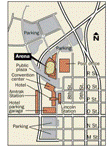Community and Regional Planning Program
ORCID IDs
Hui R. Ng https://orcid.org/0000-0002-2359-5014
Date of this Version
2023
Citation
Ng, H.R.; Sossa, I.; Nam, Y.; Youn, J.-H. Machine Learning Approach for Automated Detection of IrregularWalking Surfaces for Walkability Assessment with Wearable Sensor. Sensors 2023, 23, 193. https://doi.org/10.3390/s23010193
Abstract
The walkability of a neighborhood impacts public health and leads to economic and environmental benefits. The condition of sidewalks is a significant indicator of a walkable neighborhood as it supports and encourages pedestrian travel and physical activity. However, common sidewalk assessment practices are subjective, inefficient, and ineffective. Current alternate methods for objective and automated assessment of sidewalk surfaces do not consider pedestrians’ physiological responses. We developed a novel classification framework for the detection of irregular walking surfaces that uses a machine learning approach to analyze gait parameters extracted from a single wearable accelerometer. We also identified the most suitable location for sensor placement. Experiments were conducted on 12 subjects walking on good and irregular walking surfaces with sensors attached at three different locations: right ankle, lower back, and back of the head. The most suitable location for sensor placement was at the ankle. Among the five classifiers trained with gait features from the ankle sensor, Support Vector Machine (SVM) was found to be the most effective model since it was the most robust to subject differences. The model’s performance was improved with post-processing. This demonstrates that the SVM model trained with accelerometer-based gait features can be used as an objective tool for the assessment of sidewalk walking surface conditions.


Comments
This article is an open access article distributed under the terms and conditions of the Creative Commons Attribution (CC BY) license